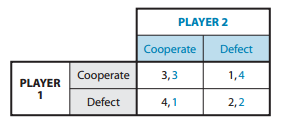Question
Suppose that a single play of a prisoners dilemma has the following payoffs: In a large population in which each members behavior is genetically determined,
Suppose that a single play of a prisoners dilemma has the following payoffs:
In a large population in which each members behavior is genetically determined, each player will be either a defector (that is, always defects in any play of a prisoners dilemma game) or a tit-for-tat player. (In multiple rounds of a prisoners dilemma, she cooperates on the first play, and on any subsequent play she does whatever her opponent did on the preceding play.) Pairs of randomly chosen players from this population will play sets of n single plays of this dilemma (where n $ 2). The payoff to each player in one whole set (of n plays) is the sum of her payoffs in the n plays. Let the population proportion of defectors be p and the proportion of tit-for-tat players be (1 2 p). Each member of the population plays sets of dilemmas repeatedly, matched against a new, randomly chosen opponent for each new set. A tit-for-tat player always begins each new set by cooperating on its first play.
(a) Show in a two-by-two table the payoffs to a player of each type when, in one set of plays, each player meets an opponent of each of the two types.
(b) Find the fitness (average payoff in one set against a randomly chosen opponent) for a defector.
(c) Find the fitness for a tit-for-tat player.
(d) Use the answers to parts (b) and (c) to show that, when p >(n -2 )/(n-1),the defector type has greater fitness and that, when p
(e) If evolution leads to a gradual increase in the proportion of the fitter type in the population, what are the possible eventual equilibrium outcomes of this process for the population described in this exercise? (That is, what are the possible equilibria, and which are evolutionary stable?) Use a diagram with the fitness graphs to illustrate your answer.
(f) In what sense does more repetition (larger values of n) facilitate the evolution of cooperation?
PLAYER 2 Cooperate Defect PLAYER Cooperate 3,3 1.4 Defect 4,1 22Step by Step Solution
There are 3 Steps involved in it
Step: 1

Get Instant Access to Expert-Tailored Solutions
See step-by-step solutions with expert insights and AI powered tools for academic success
Step: 2

Step: 3

Ace Your Homework with AI
Get the answers you need in no time with our AI-driven, step-by-step assistance
Get Started


